Do Southpaws Take Longer to Mature?

It took Sandy Koufax awhile to mature as a pitcher. (via N.Y. Public Library Picture Collection
The road to my question today began half a century ago—or a year and a half ago, depending on how you count it.
The nearer origin was Frank Jackson’s piece in the Hardball Times Baseball Annual 2016, titled, “There’s Always a Reason to Go.” The origin of his essay was a game he attended at the end of the 1966 season, meaningless to the home Phillies but vital to the visiting Dodgers, looking to clinch the pennant. Unknown to virtually everyone at the time, it would become historic for another cause: the last regular-season game Sandy Koufax ever played.
Musing on Koufax’s brilliant but truncated run of glory, Jackson wrote:
He is the ultimate poster boy for all those erratic left-handed pitchers who test the patience of their team’s management. Since southpaws are fewer in number than right-handers and typically take longer to mature, most teams will stick with them longer. No team was rewarded more for its patience that the Dodgers in the later 1950s and early 1960s.
The assertion in the middle sentence has been rattling around in the back of my brain ever since. Left-handed pitchers are clearly more scarce than right-handed pitchers. Whether they take longer to mature is not as clear.
I could just take a fellow THT writer at his word on something that sounds pretty plausible. I could also take apart the claim and see whether it holds up, because that’s what I would do if I heard it from any other source. No gold stars will be awarded for guessing which one I am doing.
To figure out which group takes longer to mature, I need to look at entire careers if possible. For my data set, I selected every pitcher who debuted in the major leagues between 1996 and 1998. That range was a compromise, both avoiding the warping effects of the 1994-95 strike years and maximizing the chances the chosen pitchers’ careers would be complete.
It turns out just one pitcher in that range lasted into the 2017 season: Bartolo Colón. He’s the only pitcher in the study, of either handedness, to pitch at age 41, or 42, or 43. Or 44, though his stats for the current season obviously are not included in this study.
Some pitchers had to be removed from the sample. Several were position players throwing an inning or two, which goes against the purpose of looking at pitcher development. Others were from countries whose circumstances distorted examination of their development, specifically Japan and Cuba. For Japan, it was because having to play for a long time in NPB before crossing the ocean cut off much of the development we’re supposed to be looking at. For Cuba, it was because their entry into the majors depended greatly on when they were able to defect, again skewing the development curve.
(I made one exception. Vladimir Núñez was born in Havana in 1975 but left Cuba young enough that he attended high school in the Dominican Republic. I decided this made his development as a pitcher normal enough to keep him in the sample.)
This bit of weeding left me with 85 left-handed and 195 right-handed pitchers. I recorded the ages of their MLB seasons and several performance stats from each year. These were ERA, FIP, walk and strikeout rates (all adjusted to league averages), plus bWAR. I also recorded batters faced for each season, finding this a little more precise than innings pitched. (In high-offense years, one inning pitched can mean a higher number of batters faced than in low-scoring years. Total pitches would be ideal, but that’s not available for earlier years.)
I will give the number of pitchers in the majors and the batters they faced for the full range of ages, left-handed and right-handed. This is mainly to show you where sample sizes may be too small to be reliable.
| L BatFaced | L # (of 85) | Age | R # (of 195) | R BatFaced |
|---|---|---|---|---|
| 252 | 2 | 20 | 1 | 367 |
| 1384 | 6 | 21 | 19 | 5414 |
| 3460 | 9 | 22 | 41 | 12358 |
| 7184 | 26 | 23 | 62 | 19673 |
| 10592 | 37 | 24 | 101 | 29637 |
| 11527 | 39 | 25 | 106 | 33984 |
| 10353 | 46 | 26 | 104 | 32129 |
| 10209 | 42 | 27 | 103 | 31713 |
| 8284 | 38 | 28 | 96 | 29193 |
| 7278 | 33 | 29 | 76 | 26681 |
| 6452 | 26 | 30 | 64 | 26656 |
| 3874 | 18 | 31 | 55 | 21626 |
| 3429 | 16 | 32 | 45 | 16796 |
| 4148 | 18 | 33 | 39 | 12518 |
| 3409 | 15 | 34 | 29 | 12070 |
| 2397 | 10 | 35 | 20 | 7865 |
| 1693 | 8 | 36 | 14 | 5485 |
| 1120 | 7 | 37 | 8 | 2677 |
| 516 | 5 | 38 | 7 | 2271 |
| 162 | 2 | 39 | 4 | 1778 |
| 0 | 0 | 40 | 2 | 826 |
| 0 | 0 | 41 | 1 | 846 |
| 0 | 0 | 42 | 1 | 815 |
| 0 | 0 | 43 | 1 | 791 |
The data probably will be most reliable between ages 22 and 35, as pitchers in the majors are less than a tenth of the full sample before and after that range. The four years longer that righties pitch in MLB are almost exclusively due to Colón. That speaks exclusively to his own personal gifts, not to righties or lefties in general.
Some patterns emerge before any examination of age. First, the ’96-’98 right-handers pitched more than their left-handed counterparts. The margin of 334,169 batters faced to 97,723 outstrips both the ratio of righty to lefty pitchers (195 to 85) and the ratio of MLB seasons posted by both groups, 999 to 403 in the righties’ favor. The righties have 49 percent more batters faced per career, and 38 percent more BF per season. (They also have longer careers than lefties counting by seasons, 5.12 to 4.74.)
This derives from how southpaws have been used over the last 20 years. Every bullpen seems to need at least two left-handed options, including one who is a pure left-on-left specialist. Both those trends lead to left-handers pitching to fewer batters. While lefties thus become sought after, it’s in a role that renders them fungible, easily discarded should they turn ineffective for a while. Jackson’s statement that teams stick with southpaws longer is possibly true for the subset of starting pitchers, but in general is untrue, or at least superseded by modern doctrines.
The right-handers are also more effective pitchers, at least going by Baseball-Reference’s version of WAR. The ’96-’98 righties accumulated 665.5 bWAR over their careers against just 147.6 bWAR for the left-handers. Measuring per career, per season, or per batter faced, the righties had a better WAR rate. (For example, righties posted 1.99 bWAR per 1000 batters faced while lefties managed 1.51 bWAR/KBF.)
While interesting, these aren’t the facts I was trying to unearth. They do, however, guide my look at the pace of pitcher maturation. They are a reminder to judge the two groups by their own peaks and valleys, not only against each other’s performance.
The simplest measure of maturation is to count how many of our sampled pitchers were playing in the majors at various ages. This chart shows the percentage of each handedness of pitchers in MLB at each age, from 20 to Bartolo.
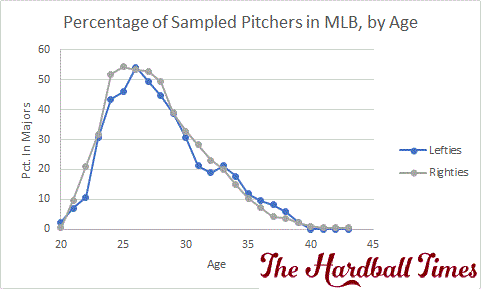
Going by a single standard, the righties could be said to mature marginally sooner. Right-handers have more than 50 percent of their cohort in the majors from ages 24 to 27, while left-handers manage it only at age 26. Make the cutoff 40 percent, however, and they both have the same range, from 24 to 28. With the cutoff at 33 percent, they are even again, from ages 24 to 29.
Go by separate standards, and again the lefties mature marginally later, perhaps. The lefties’ single-year peak comes a year later than the righties’ (26 to 25), and this holds for two-year (26-27 to 25-26) and four-year (25-28 to 24-27) peaks as well. For three-year peaks the age ranges are identical, and this holds also for peaks of five, six, and eight years. (A tie in the left-handers’ numbers meant they didn’t have a seven-year peak as such.)
Lefties do have a greater presence in the majors during their mid-30s, but the margin is not great. It’s also balanced by a larger righty presence during the early-30s, with a bigger margin while it lasts. These two events roughly cancel out.
By mere presence in the majors, the southpaws may mature later, though it looks like a matter of months instead of years. More telling should be the patterns of performance in the majors, and there are several ways we can look at this.
I will start with batters faced, a simple look at how much confidence their teams have in sending them to, and keeping them on, the mound. First is batters faced per pitcher in the sample, whether or not he’s in the majors yet. (I’d say a BF of zero speaks to the confidence your parent club has in you.)
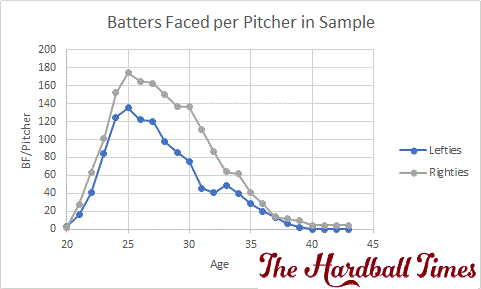
Righties have the higher BF rates, which we knew already. The peak values for both hands come from age 24 to age 27, with the righty peak perhaps stretching to age 28. No clear difference, and the unclear difference would have lefties maturing a touch earlier, not later.
Next is batters faced per pitcher in the majors.

The lefties’ peak comes at age 22, but with just nine pitchers from the full left-handed sample of 85 in MLB at that age, this probably should be discounted. Even with that done, the long peak comes much earlier for lefties than righties. The huge spike in the 40s for right-handers is, of course, Colón’s solo act, discounted statistically.
The batters-faced method does not support the theory of later lefty maturation, at least as far as innings pitched tracks with maturing as a pitcher.
We’ll look next at walks and strikeouts, which have a more direct connection with pitching performance. I adjusted both to the league and year, putting them on plus scales (BB+ and K+) where 100 is the average and higher means more of each.
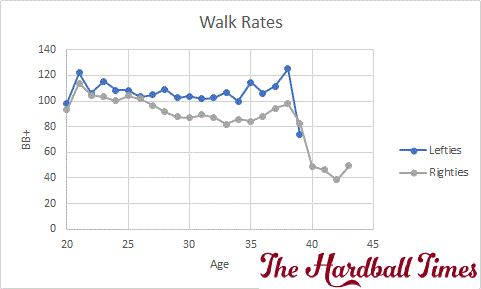
Right-handers’ wildness is clearly concentrated in their youth, while left-handers need much longer to shake off theirs, and arguably never quite do. That’s true whether you are measuring them against righties or against themselves. (The late righty plunge is all Colón and his excellent command. Indeed, everything from 40 onward for righties is all Colón.)
This is the strongest evidence yet of later maturation for southpaws, and, fittingly, it tracks with how Koufax himself turned the corner. For his first six seasons, Koufax’s walks-per-nine-innings rate was never lower than 4.4. In 1961, at age 25, he drove it down to 3.4, and within two more years would have it at half of that. His strikeout rate stayed fairly steady as he did so, but his total strikeouts spiked as he was trusted with more innings. He would lead the majors in punchouts with 269 in 1961, the year he became what we think of when we hear the name Koufax.
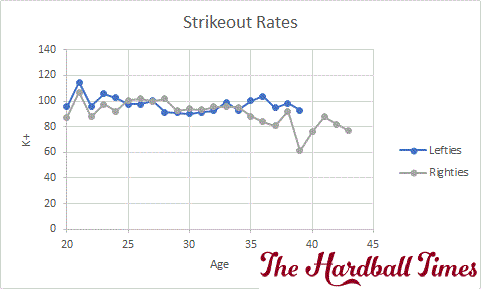
For strikeouts, youth is served in both cases. K rates ride high early, then pick a year in which to make a long-term drop. The drop age for lefties is 28; for righties, it’s 29. We must count this as evidence against the theory. One could also point to how the lefties exhibit a mid-thirties Indian summer (note: I don’t mean going to Progressive Field in July). However, the sample size there is small enough (10 pitchers at age 35, and eight at age 36) to give it diminished weight.
Walks agree with our hypothesis, but strikeouts disagree. Next we’ll look at ERA and its cousin FIP. I figured both in plus terms, mainly for my ease of calculation. Just remember that higher is better, as it was for strikeouts (but not walks). Also, be aware of the truncated vertical axes for ERA+ and FIP+, done to make movements more discernible.
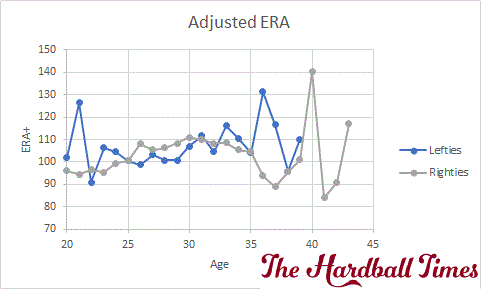
Results for ERA+ are fairly clear. The right-handers break out to a higher level at age 26, while for the left-handers the breakthrough comes at age 30. That’s exactly the type of pattern we are looking for—which makes the following chart all the odder.
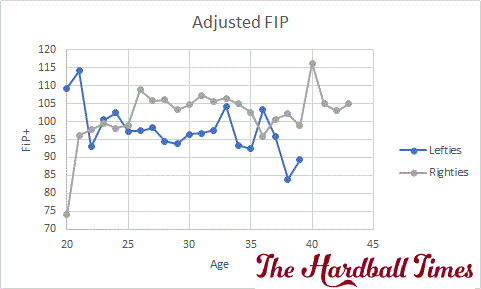
For FIP+, the lefties do well early before dropping off at age 25, only spottily climbing back well into the 30s. Right-handers show a more expected progression, making a big step up at age 26 just as the ERA+ numbers did. I don’t have an explanation for the lefties’ divergence between ERA+ and FIP+ patterns, or for why their FIP+ underperforms their ERA+. (Or is ERA out-performing FIP?) In any case, it’s a mark against the case for late lefty maturation, though perhaps smaller than the ERA+ mark in its favor.
Finally, we’ll look at the bWAR measures. First up is the ratio of WAR to all pitchers in the respective handedness samples.

The left-handers peak from ages 23 to 27, with an added bump at 30. The right-handers peak from ages 25 to 30. This is a clear example of southpaws maturing first, or at least their numbers doing so.
When we shift to counting only the pitchers in the majors, things get much wilder. I cut off the vertical axis at 2 bWAR per pitcher, due to a couple Colón years, to keep the scale manageable.
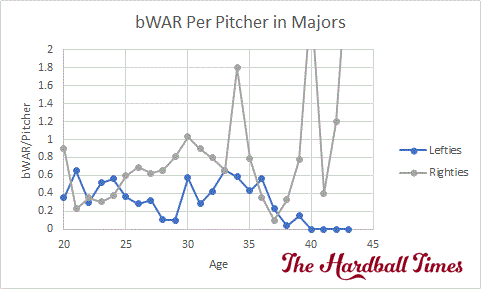
There is no obvious peak for the lefties: one can make cases for their peak starting at age 21 or ending at age 36. The righties are somewhat clearer, with their five best non-Colón seasons coming between ages 29 and 34. Making a definitive statement one way or the other would be tough, but claiming lefties mature later than 29 to 34 would be next to impossible.
My third and last angle on bWAR examines it as a rate statistic, measured against every 1000 batters faced by the pitchers.
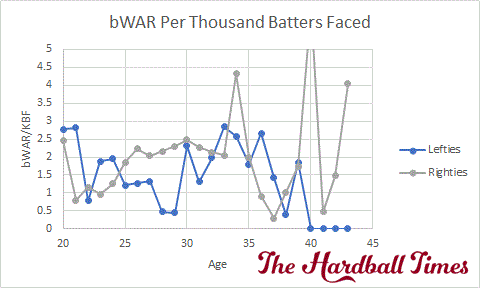
The right-handers have a long plateau from ages 26 to 35, with an age-34 spike (and a couple of Colón spikes). The left-handers peak both earlier and later. Their first peak, 20 to 24, partly can be discounted for small samples at the youngest ages, but the 23-24 sub-peak is more genuine. A later peak range arrives at ages 30 to 36, meaning the southpaws peak both before and after the righties. Once more, a distinct pattern does not emerge.
Where does this cascade of charts and figures leave us? Three of the categories—walks, ERA, and percentage of sampled pitchers being in the majors—indicate a later peak for left-handed pitchers, the latter somewhat more mildly than the others. Four other categories—batters faced per pitcher in the bigs, strikeouts, FIP, and bWAR rate for all sampled pitchers—indicate the opposite is true. The remaining three categories gave no useful evidence.
Even if we drop the batters-faced-per-pitcher ratios, easily dominated by modern bullpen strategy rather than actual talent and performance, that leaves the score at three to three. Positive evidence from walks is offset by the strikeout numbers; ERA is likewise countered by FIP. The positive categories show somewhat stronger trends, but not enough so to change the conclusion.
The theory that left-handed pitchers take longer to mature than right-handed pitchers is not true. At the least, the effect is so subtle that it cannot clearly be found within the wide net I cast for corroborating data.
I was afraid this would happen. I’ve wound up contradicting the statement of a fellow Hardball Times writer, whose fine work does not merit the “gotcha” treatment. Frank Jackson should take as consolation that I am liable to give this treatment to anybody, all the way up to Bill James and The Glory of Their Times. Indeed, I’ve done this to myself, and more than once!
If Jackson erred, it was perhaps in being seduced by a tempting narrative. (An old story-writer like myself has nothing against narratives, but fiction can be much neater than reality usually is.) The belief that southpaws take longer to develop is linked in Jackson’s essay to the career path of Koufax, the specific prefiguring the general.
It may instead be that Koufax’s special case is so compelling that it warps our perceptions of all lefty pitchers. The Dodgers gained so much from their patience as Koufax struggled to unlock his potential. From that, not only do fans learn the lesson that lefties need extra time to reach their peaks, but fans assume teams learned and apply that same lesson.
Possibly the teams did. There may have been a stretch of time when left-handed pitching prospects got a longer leash, an extended opportunity to make things click. Frank Jackson’s casually stated assertion may have been true—for a time. But that time has passed.
Today, there is a ticking clock behind not just lefties, but any pitcher in the majors striving to put it all together. I do not mean age, though that is still true. I mean the limited contractual control their teams have over them.
Nowadays, take six years to build a raw major-league talent to his full power, as the Dodgers did Koufax, and he’ll terrorize the league…for whichever team snaps him up in free agency. Far better, far wiser, to abandon the plan after a couple years and convert him to the bullpen so you’ll get some decent value out of his fastball before you lose him.
That may be why we don’t see lefties, at least lefty starters, taking the long road to peak performance in the current era. The same thought processes would be used with righties, of course, but if they’re faster to get on track, their development won’t be short-circuited as often. In any case, lefties and righties alike would be made to fit the pattern dictated by the approach of free agency.
If you are ever somehow inveigled into a debate where you have to defend the old reserve clause, this may be the best argument in your favor: that it limits the time teams can take to develop players to their fullest and some day could cost us a new Sandy Koufax. If it hasn’t already.
That’s not a conclusion I had anticipated reaching when I started this work. Finding something unexpected, however…yes, I should have anticipated that.
References and Resources
- Frank Jackson, “There’s Always a Reason To Go,” in The Hardball Times Annual 2016
- Baseball-Reference
In the tradition of the priest and geometer Giovanni Saccheri, who set out to prove that Euclid’s parallel postulate was valid and instead proved that it was not.
I thought part of the reason that Koufax was in the minors so long was because he was a Bonus Baby and the Dodgers were forced to have him on the major league roster. If he was in the minors, his career arc would have looked more normal and they might not be praised for their patience.
There are also a couple of more recent lefties, born a year apart who serve as exemplars of late development: Randy Johnson and Jamie Moyer. They both were below average pitchers in their twenties, but turned it around in their thirties (and forties) to become a solid number two (in the case of Moyer) and one of the best pitchers ever (in the case of Johnson). Were they treated differently because they were lefties? Maybe, but I think a 6-10 righty with 100 MPH fastball would be given plenty of chances.
I meant to add that these examples also cloud people’s thinking about the late development of lefties.
No doubt anecdotal examples are the primary reason why people even buy into this, but I also look at the lexicon of words used to describe players.
Have had anyone ever heard the term “crafty righty” to describe any pitcher ever? I haven’t.
If lefties are supposed to be these 30-something year olds who get guys out more because of guile and wisdom than actual ability, then the opposite must also hold true for righties.
It’s things like this that I think are the primary reason why people have issues with accepting Sabermetrics. Reality simply isn’t as interesting or as uplifting as fantasy in a lot of cases.
It just surprises me how many knowledgeable people still buy into these old wise tales that I would have figured got debunked 20 years ago.
That’s a really good point. It’s true in sports, politics, all walks of life. Reality is often boring or confusing.
Not sure the attitudes really got debunked.
Jack Clements retired as a C in 1900. He was apparently pretty good defensively – as a lefty. So has no lefty C since then ‘matured early enough’ to play MLB (or for that matter anything beyond T-ball) as a catcher before they collect SS checks? Or are lefties just a bit too flaky, independent, anti-authority to have an important field job like C?
Perhaps in another 100 years, there will actually be a sample size to test the hypothesis. Until then, we can revel in all the reasons why we needn’t bother finding out.
There’s no logical reason why lefties should take longer to mature than righties, but, perhaps there is some issue in the fact that they will be facing more right-handed hitters than left-handed so they don’t get as much of a platoon advantage while they are developing?
My understanding is that Koufax was generally misused by Walter Alston in his early days, possibly for some untoward reasons.
Koufax was an interesting situation. At the time the Dodgers signed him he had only pitched about 20 games in his life. But he had such a strong arm, a ton of potential, and they had to give him a bonus contract – or he would be going to college. So they put him on the roster – not to his benefit because the Dodgers were in pennant races in 1955 and 1956 so he got few chances to pitch. He was used somewhat erratically – in 1957 he was pitching regularly and doing well – but when a long stretch when he did not pitch. Whether Walter Alston did not have faith in him or some other reason was never stated.
The thought has been stated if he had minor league time he may have developed sooner. Perhaps – on the other hand he could have injured himself and we never would have heard of him today. Koufax could be given the time he needed because the Dodgers could keep his rights due to the reserve clause. Today they would have kept him 6 years – he would go free agent and star for someone else. For every Koufax there are many, many players who don’t develop and we never hear of again.
While he undoubtedly developed sort of late, I don’t know that we should be using Koufax as an example here because of the difficulty of separating his actual development from three (at least) strong external factors that would have had an influence on his performance.
1, He went from pitching in Ebbets Field to pitching in the Coliseum to pitching in (1962) Dodger Stadium.
2, Starting in 1962, 22 percent of his opponents were expansion team players, and one of those teams would be celebrated as one of the worst teams in MLB history during the course of his career.
3, About that same time, MLB gave him (and, yes, all MLB pitchers) a huge advantage by expanding the strike zone while allowing them to throw off huge mounds, shering in the second Deadball Era.
Now it’s true that some of these factors were available for other pitchers as well, and they didn’t turn into Koufax, but it makes me wonder if somehow Koufax’s makeup gave him the ability to take the biggest advantage of all of them. Or that pitching in Dodger Stadium while other pitchers were toiling in places like Crosley Field was a bigger advantage than we might realize even today.
Just to examine one these factors, his career triple slash line against the Mets was .170/.226/.235 for a ridiculous OPS of .461. Against the Astros, it was .184/.232/.272, OPS of .504. These are by far his best lines against any opponent. And his SO/W ratio vs. the Astros was an absurd 5.33.
To take a cursory look at another, here are his career slash lines by home ballpark:
Ebbets .241/.324/.419 with a 2.20 K/W
Coliseum .228/.326/.395 with a 1.95 K/W
Dodger .176/.221/.247 with a 5.31 K/W
Development or coincidence?
His career road split was .212/.285/.330 FWIW
The point isn’t that he wasn’t a great pitcher (for a short time). The point is, of all the LHPs in history, he arrived at a uniquely opportune place and time and may have been uniquely skilled to take advantage of the convergence of forces that kept making it easier and easier for him to do his job.
So what’s true development and what is an illusion created by those forces?
It would be impossible to track without some sort if giant baseball player census project, but the focus of this article led me to a follow-up question: Is the maturation curve significantly different if the LHP is a “real” left-hand-dominant person vs a right-hand-dominant person taught to throw with their left hand because of the novelty value of left-handed pitchers? Or, perhaps more specifically, do right-handed people who pitch lefty account for any increased maturation time because they’re learning a difficult skill in a disadvantageous way compared to other pitchers (left or right handed) who are learning the craft with their dominant (and therefore better) arm?
Besides anecdotal evidence from pitchers themselves, we know that there must exist a certain percentage of the LHP population that are, for lack of a better term, faking it. 5 minutes of google says that even just over the last 5-7 years, LHPs make about 1/4 to 1/3 of all MLB starts. But it’s usually accepted that only roughly 10% of the world’s population is naturally left-hand-dominant. Even allowing for some level of selection bias and preference for lefties over equally talented or even slightly more talented righties, I don’t think that makes up for the entire 15-20% representational disparity. So obviously a non-insignificant chunk of LHPs are really right-handed people masquerading as southpaws for baseball purposes.
I know that the difference may not be as significant since fake lefties will learn to throw with their left arm from a young age and continuously throughout their development to the point that it should come close to mimicking the ability of a person using their dominant arm. But it still makes me curious.
Throwing is a very HANDED thing – unlike batting. It’s really quite easy to switch big muscle activities – I bat lefty, golf righty (but always carry one lefty wedge in the bag), and play tennis with whichever hand I want on that shot. But I am not ambidextrous – I am lefty.
Small muscle activities – like controlling where the ball goes when you throw – is much more difficult to simply ‘switch’. Absent physical injury that forces the switch (Billy Wagner) or switching very very early (Pat Venditte – at age 3 – which can make someone ambidextrous), I can’t name anyone who switched their throwing handedness from righty-to-lefty. Pablo Sandoval is a lefty who learned to throw righty – but that was because he wanted to play SS and lefties aren’t allowed to play that position. Brooks Robinson was left-handed but learned righty throws very very early. A natural righty who wants to throw lefty would, in baseball, automatically eliminate himself from most positions. What is the incentive there?
Jfee,
I am a righty but sometimes out of desperation playing tennis, I will hit a shot using my left hand (and have actually won points). But, I always batted lefty playing baseball. I always wondered why people like me throw right-handed but bat left-handed. It’s not something I consciously did; it just happened that way. When I was a kid, my uncle taught me to play golf right-handed (because he had a set of right-handed clubs he wanted to give me). But I always putted left-handed and I never batted right-handed. Seems sort of weird.
I agree, though, that throwing would be very different. I can’t imagine being able to learn to throw left-handed and, as you say, there’s not much utility in it except to pitch.
As an aside – if there is a delayed development re lefty pitchers, it is prob not because anyone is faking it but because with pitcher/batter – the opposite-handed advantage goes to the batter, the same-handed advantage goes to the pitcher. And there’s more righty batters than lefty batters.
I think you misunderstand. I didn’t mean that players grow up throwing one way and switch sides later in their development. I meant kids who are naturally right-handed but learn to pitch lefty from an early age, possibly because the adults guiding their development realize the benefit of them being left-handed if they want to be pitchers.
Like I said, I have a hard time believing that even if you account for the baseball preference for left-handed pitchers creating a larger market for them, I don’t believe it can account for the entirety of the difference between the proportional representation of lefties in the general population versus the representation that occurs in baseball (where ~25-33% of starting pitchers are lefties, and ~20% of players overall when you start accounting for fielder handedness all put up against the roughly 10% of all people worldwide). To that end, I have to believe that a certain number of left-handed pitchers aren’t truly left-handed in terms of performing everyday tasks. They throw left-handed, but write right-handed, eat right-handed, use non-handed tools like hammers or handsaws right-handed, etc. Yes, I recognize that there’s no incentive to being a left-handed thrower if you want to be an infielder, but I’m not talking about the idea of people becoming lefty throwers as a general baseball skill, but rather doing it specifically as a pitcher skill.
I understand what you’re saying. I just can’t think of a single person who’s ever actually specifically done that (righty-to-lefty) except Venditte and the injury stuff. I would think more names would be known if it were actually done more. Brooks Robinson’s dad (who played semi-pro 2B) taught him to throw right-handed because he knew the structural advantages of throwing right-handed as a position player (ie you get to play something other than 1B). Likewise, there is definitely a structural advantage to batting lefty – 3 feet or so closer to first base – so there are a lot of ‘fake’ lefties at the plate.
But what is the structural advantage to pitching lefty – esp if you create a learning hurdle to do so? Righty pitchers (not lefty pitchers) have the advantage against righty batters – who are still the big majority of batters. Lefty pitchers only have a fleeting advantage of ‘haven’t seen that before’ – and that ends by Little League.
Its only at the high professional level where left handed batters become more common than their general distribution in the overall population.
Left handed pitchers are primarily valuable due to their platoon advantage and the fact that left handed batters get so many less development opportunities against them that they can make the major leagues without ever learning to handle the same-handed breaking ball … I had to get over that fear of a curveball that looks like it’s coming straight at my face just to play American Legion baseball as a 17 year old right-handed person.
The incentive to be left handed as a pitcher is only in the professional ranks, and I suspect few people want to groom their kid to be a pitcher from such a young age, given pitcher failure rates. Makes much more sense to teach throws R/Bats L as that is a huge advantage in playing many positions and hitting starting right in little league.
Well, there is some advantage to being a left-handed pitcher (e.g., many of the best hitters are lefties, in part, I assume, because of the platoon advantage). And teams look for lefties; so it probably isn’t surprising that lefties might be overrepresented as pitchers relative to the general population. And I assume that someone learning to throw left-handed would not be able to throw as hard as with his natural hand. If someone was a hard thrower right-handed, it really would make no sense to switch them.
Don’t quite understand why Sandy Koufax was chosen as “the poster boy” for the article.
Pitching in Ebbets Field and then as a lefty in the LA Coliseum would end most pitching careers before one even got a chance to “mature.”
2 words; Johnny Podres
Unfortunately, three years of debuts is not a large enough sample size from which to draw conclusions — which is suggested by the FIP/ERA discrepancy. A handful of pitchers could have signficantly skewed the curves.
Buc Daddy mentioned it….but Bill James shattered the Koufax myth long ago, the same myth revived in this article. Koufax was a product of Dodger Stadium, plain and simple. Had he not began pitching there in 1962, then ending in 1966, his numbers go from incredible to merely very good, more in the vein of Gibson/Marichal/Ford/ and others who starred in the 60’s. Check his road/home splits.
I don’t recall the source for this, but I remember reading a writer was with Willie Mays around 1959 or 60 and they were waiting to talk to a Giants’ official, probably owner Horace Stoneham or VP Chub Feeney.
They overheard some chatter about Koufax being traded and Mays said, “I hope they trade him to us. He’s got a fastball you can’t see.”
And Mays did relatively well against Koufax .278 .426 .536 slash line.
I really enjoyed reading this. Thank you!…